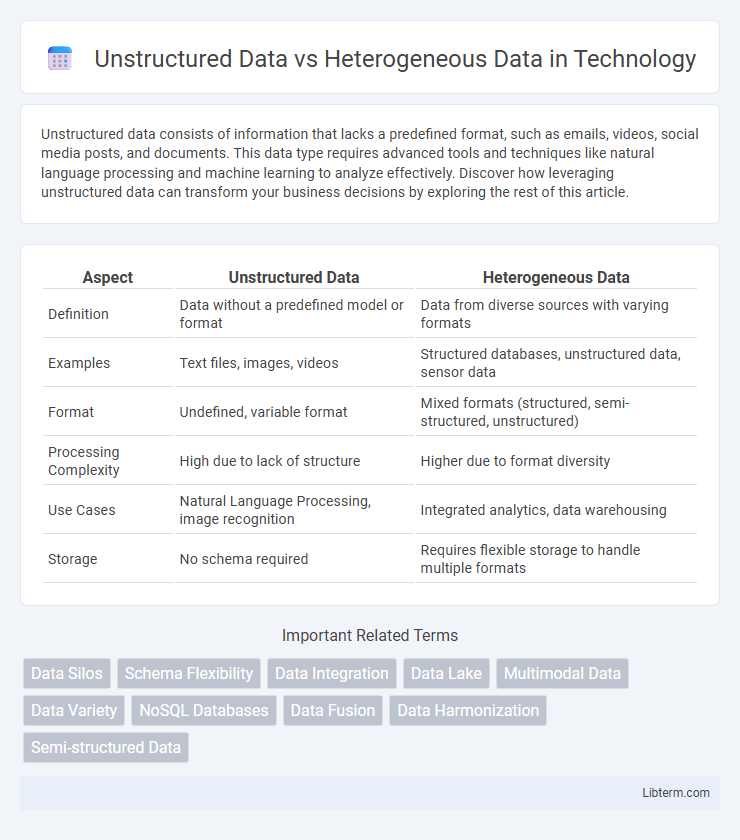Unstructured data consists of information that lacks a predefined format, such as emails, videos, social media posts, and documents. This data type requires advanced tools and techniques like natural language processing and machine learning to analyze effectively. Discover how leveraging unstructured data can transform your business decisions by exploring the rest of this article.
Table of Comparison
| Aspect | Unstructured Data | Heterogeneous Data |
|---|---|---|
| Definition | Data without a predefined model or format | Data from diverse sources with varying formats |
| Examples | Text files, images, videos | Structured databases, unstructured data, sensor data |
| Format | Undefined, variable format | Mixed formats (structured, semi-structured, unstructured) |
| Processing Complexity | High due to lack of structure | Higher due to format diversity |
| Use Cases | Natural Language Processing, image recognition | Integrated analytics, data warehousing |
| Storage | No schema required | Requires flexible storage to handle multiple formats |
Understanding Unstructured Data
Unstructured data refers to information that lacks a predefined format or organized schema, such as emails, social media posts, videos, and sensor outputs. This type of data is characterized by its complexity and diversity, making it challenging to process and analyze using traditional relational databases. Understanding unstructured data involves leveraging advanced techniques like natural language processing, machine learning, and data mining to extract meaningful insights and convert it into actionable intelligence.
Defining Heterogeneous Data
Heterogeneous data refers to diverse data types originating from multiple sources, characterized by variations in structure, format, and semantics. Unlike unstructured data, which lacks a predefined model, heterogeneous data encompasses structured, semi-structured, and unstructured forms, requiring complex integration methods for analysis. Effective processing of heterogeneous data involves schema matching, data transformation, and fusion techniques to derive meaningful insights in big data environments.
Key Differences Between Unstructured and Heterogeneous Data
Unstructured data refers to information that lacks a predefined format or organization, such as emails, videos, and social media posts, making it difficult to analyze using traditional databases. Heterogeneous data encompasses multiple types and formats of data, including structured, semi-structured, and unstructured sources, integrated from diverse systems or platforms. The key difference lies in unstructured data's singular lack of formatting versus heterogeneous data's composition of varied data types and sources combined in a unified dataset.
Sources of Unstructured Data
Unstructured data originates from diverse sources such as social media posts, emails, videos, images, sensor outputs, and audio recordings, which lack a predefined data model or organizational format. These sources generate vast volumes of complex information that require advanced processing techniques like natural language processing and computer vision to interpret. In contrast, heterogeneous data encompasses a mixture of structured, semi-structured, and unstructured datasets derived from multiple origins and formats, integrating complex relationships for comprehensive analysis.
Common Examples of Heterogeneous Data
Heterogeneous data encompasses diverse formats and types such as text documents, images, audio files, videos, sensor readings, and structured databases, often originating from multiple sources like social media, IoT devices, and enterprise systems. Unlike unstructured data, which lacks a predefined format, heterogeneous data combines structured, semi-structured, and unstructured data forms, requiring advanced integration and processing techniques. Common examples include customer profiles combining transaction records, social media posts, and call center interactions, as well as healthcare data blending electronic health records, medical imaging, and genomic sequences.
Challenges in Managing Unstructured Data
Unstructured data, lacking a predefined format, poses significant challenges in storage, searchability, and analysis compared to heterogeneous data, which involves multiple data types but may have some structure. Managing unstructured data requires advanced techniques like natural language processing and machine learning to extract meaningful insights from text, images, audio, and video files. Scalability and integration with structured databases further complicate the handling of unstructured data, increasing processing time and resource demands.
Integrating Heterogeneous Data Systems
Integrating heterogeneous data systems involves combining diverse data types and formats from multiple sources into a unified platform, enabling seamless data analysis and decision-making. Unlike unstructured data, which lacks a predefined schema, heterogeneous data incorporates structured, semi-structured, and unstructured formats, requiring advanced data integration techniques like data mapping, transformation, and metadata management. Effective integration enhances data interoperability, reduces redundancy, and supports comprehensive analytics across varied enterprise systems.
Tools for Processing Unstructured and Heterogeneous Data
Tools for processing unstructured data, such as Apache Hadoop and Apache Spark, enable efficient storage and analysis of diverse data types like text, images, and videos. For heterogeneous data, platforms like Talend and Informatica provide robust data integration and transformation capabilities to unify disparate sources with varying formats. Machine learning frameworks including TensorFlow and PyTorch further enhance the extraction of insights from both unstructured and heterogeneous datasets by supporting complex data processing workflows.
Importance of Data Structure in Analytics
Unstructured data consists of information that lacks a predefined model or organization, such as text, images, and videos, while heterogeneous data combines diverse formats and sources, including structured databases, semi-structured logs, and unstructured content. The importance of data structure in analytics lies in its ability to enable efficient data integration, processing, and analysis, directly impacting the accuracy and speed of insights. Structured data facilitates easier querying and machine learning model training, whereas managing unstructured and heterogeneous data requires advanced techniques like natural language processing and data normalization to extract valuable information.
Future Trends in Data Management
Future trends in data management emphasize advanced AI-driven analytics and machine learning algorithms to extract meaningful insights from unstructured data, such as text, audio, and video. The rise of heterogeneous data integration platforms enables seamless processing and analysis of diverse data types from multiple sources, improving decision-making accuracy. Innovations in real-time data processing and edge computing are expected to enhance handling of both unstructured and heterogeneous data in complex environments.
Unstructured Data Infographic

 libterm.com
libterm.com